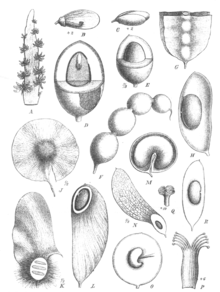Lonchocarpus
Lonchocarpus is a plant genus in the legume family (Fabaceae). The species are called lancepods due to their fruit resembling an ornate lance tip or a few beads on a string.
| Lonchocarpus | |
|---|---|
 | |
| Center (F): A pod of Lonchocarpus monilis | |
| Scientific classification | |
| Kingdom: | Plantae |
| Clade: | Tracheophytes |
| Clade: | Angiosperms |
| Clade: | Eudicots |
| Clade: | Rosids |
| Order: | Fabales |
| Family: | Fabaceae |
| Tribe: | Millettieae |
| Genus: | Lonchocarpus Kunth 1824 |
| Species | |
| Synonyms | |
| |
Cubé resin is produced from the roots of L. urucu and namely ''L. utilis (cubé). It contains enough of the toxic rotenoids rotenone and deguelin to be used as an insecticide and piscicide. As these are naturally occurring compounds, they were formerly used in organic farming. Since it is highly unselective and kills useful, as well as pest, animals, it is considered harmful to the environment today. Also, chronic exposure to rotenone and deguelin seems to increase the risk of Parkinson's disease even in mammals, for which these compounds are less acutely toxic than for fish and insects.[1] On the other hand, deguelin might be useful in cancer therapy if it can be applied directly into tumors,[2] and Lonchocarpus root is used to a probably insignificant extent by indigenous peoples as an aid in fishing, e.g. by the Nukak who call it nuún.
The bark of L. violaceus (balché tree) is traditionally used by the Yukatek Maya version of the mildly intoxicating mead, balché, which was held in the highest esteem in antiquity and considered sacred to the god of intoxication. It is still drunk today and was, after the Spanish conquest of Yucatán, considered a less harmful alternative to the alcoholic beverages imported by the Europeans. It is not quite clear if roots were also used to produce balché, and to what extent toxic isoflavones are also present in L. violaceus. The potency of balché may be increased by using honey produced from L. violaceus nectar gathered by the Maya's traditional stingless bees.
Some insects have evolved the ability to deal with Lonchocarpus toxins and feed on these plants. They include a possible new taxon in the two-barred flasher (Astraptes fulgerator) cryptic species complex which seems to have acquired this ability only quite recently and is found at least on L. costaricensis and L. oliganthus.[3]
Species
Selected species include:
- Lonchocarpus calcaratus
- Lonchocarpus capassa Rolfe
- Lonchocarpus chiricanus
- Lonchocarpus kanurii
- Lonchocarpus laxiflorus
- Lonchocarpus miniflorus
- Lonchocarpus molinae
- Lonchocarpus phaseolifolius
- Lonchocarpus phlebophyllus
- Lonchocarpus pluvialis – cuquí
- Lonchocarpus retiferus
- Lonchocarpus sanctuarii
- Lonchocarpus santarosanus – chapelno blanco
- Lonchocarpus trifolius
- Lonchocarpus urucu – barbasco
- Lonchocarpus utilis – cubé, common lancepod
- Lonchocarpus violaceus (Jacq.) Kunth
- Lonchocarpus yoroensis
Footnotes
- Caboni et al. (2004)
- Udeani et al. (1997)
- Hébert et al. (2004), Brower et al. (2006)
References
- Brower, Andrew V.Z. (2006): Problems with DNA barcodes for species delimitation: ‘ten species’ of Astraptes fulgerator reassessed (Lepidoptera: Hesperiidae). Systematics and Biodiversity 4(2): 127–132. doi:10.1017/S147720000500191X PDF fulltext
- Caboni, Pierluigi; Sherer, Todd B.; Zhang, Nanjing; Taylor, Georgia; Na, Hye Me; Greenamyre, J. Timothy & Casida, John E. (2004): Rotenone, deguelin, their metabolites, and the rat model of Parkinson's disease. Chemical Research in Toxicology 17(11): 1540-1548. doi:10.1021/tx049867r PMID 15540952 (HTML abstract)
- Hébert, Paul D.N.; Penton, Erin H.; Burns, John M.; Janzen, Daniel H. & Hallwachs, Winnie (2004): Ten species in one: DNA barcoding reveals cryptic species in the semitropical skipper butterfly Astraptes fulgerator. PNAS 101(41): 14812-14817. doi:10.1073/pnas.0406166101 PDF fulltext Supporting Appendices
- Udeani, George O.; Gerhäuser, Clarissa; Thomas, Cathy F.; Moon, Richard C.; Kosmeder, Jerrome W.; Kinghorn, A. Douglas; Moriarty, Robert M. & Pezzuto, John M. (1997): Cancer Chemopreventive Activity Mediated by Deguelin, a Naturally Occurring Rotenoid. Cancer Research 57(16): 3424-3428. PMID 9270008 PDF fulltext